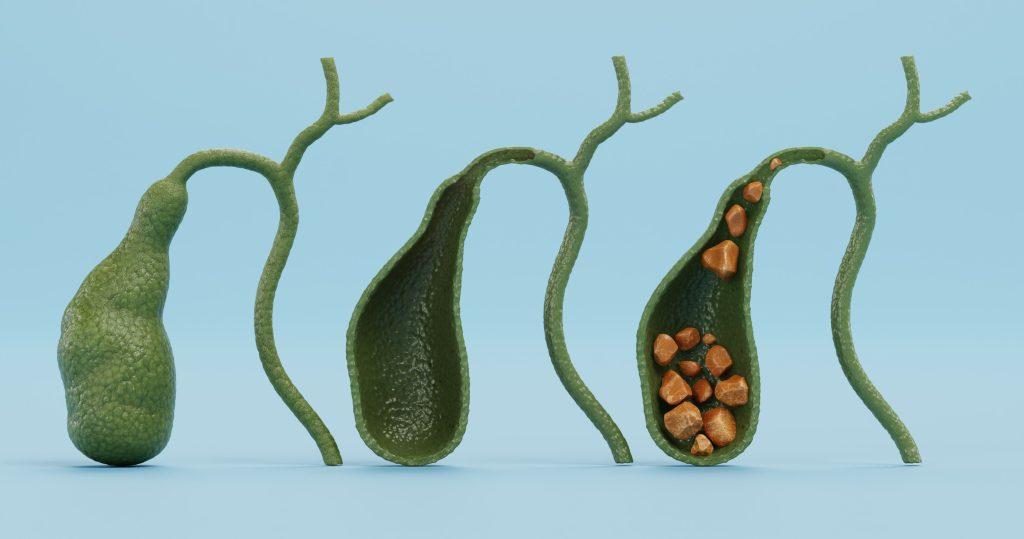The gallbladder is a small, pear-shaped organ located under the liver. Its main function is to store bile produced by the liver and release it into the common bile duct – a conduit to the small intestine – during or shortly after a meal. Bile is essential for digesting fat and fat-soluble vitamins.
When a person digests a meal containing fat, for example, fried food, creamy dressings, or meats with a large number of fats. The gallbladder is called into action. It starts contracting in response to the fat in the meal to absorb it and absorb vital fat-soluble vitamins.
If the gallbladder has stones in it or it’s not able to contract adequately then one may start experiencing symptoms related to the abnormal function of the gallbladder.
Typically, patients with symptomatic gallbladder disease begin to feel pain – whether dull or sharp – in the upper right quadrant of their abdomen, just under the rib cage. Gallstone issues are also characterized by an increase in pain shortly after eating. After consulting with a physician, a preliminary diagnosis typically requires a medical history and is confirmed with a simple ultrasound.
However, symptoms of gallbladder disease or malfunction may also be nonspecific. These symptoms may include nausea & vomiting after eating a meal; diarrhea, clay-colored, and occasionally difficult to flush stools (due to the large fat content in the stool which couldn’t be absorbed because bile was lacking). When the gallbladder is sick, it is not able to excrete the bile, somewhat similar to a bruised muscle when used. The body responds with the above symptoms to avoid forcing the gallbladder to contract.
Common Gallbladder Diseases and Their Causes
Gallbladder disease is very common in the United States in part because of increased consumption of saturated fatty meals, the rising trend in excess weight, and obesity, and represents a spectrum of possible conditions.
The majority of gallbladder-related issues revolve around gallstones, which are hardened pieces of bile. Gallstones come in two forms – cholesterol stones – which those made up of more cholesterol than bilirubin, and pigment stones, which are mostly bilirubin. The most common causes of gallstones include excess weight, rapid weight loss, birth control pills, pregnancy, family history, diabetes, and liver disease. Gallbladder disease affects women (who are affected by hormonal changes during pregnancy, hence increased symptomatic gallstones during and after pregnancy) more than it does men.
The most common form of gallbladder disease is cholecystitis – the inflammation of the gallbladder. Acute cholecystitis represents short-term inflammation, while chronic cholecystitis is inflammation that continues over several months or years. Acute cholecystitis can be caused by gallstones, excessive alcohol consumption, certain medications, and benign or malignant tumors. Chronic cholecystitis often results from a series of many acute attacks and typically leads to the shrinkage of the gallbladder and its inability to store or release bile. Complications of acute cholecystitis can include gangrene, due to restricted blood flow, and an abscess, both of which can be very dangerous.
Complications Associated With Gallbladder Disease
One of the most serious complications related to gallbladder disease and gallstones happens when a stone shoots out of the gallbladder and blocks the opening to the common bile duct. In addition to pain, bile outflow is completely occluded. This leads to a life-threatening infection (known as sepsis). This is a medical emergency requiring rapid evaluation, initiation of broad-spectrum antibiotics, and immediate extraction of the stones impacted in the common bile ducts.
Furthermore, the gallbladder may become inflamed and potentially burst. Gangrene or an abscess may form, both of which could be fatal if left untreated. Many patients will show symptoms of jaundice or yellowing of the skin.
Some patients may also develop pancreatitis, an inflammation of the pancreas. This may occur if the gallstones block the drainage system of the pancreas, which shares a small portion of its duct with the common bile duct then severe inflammation of the pancreas may ensue. This is another life-threatening condition that may be a consequence of gallstones.

Treatment for Gallbladder Disease
The gallbladder is a nonessential organ (which means the body has the capacity to adapt and compensate for its absence), so most treatments for gallbladder disease revolve around removing the entire organ – a procedure known as cholecystectomy.
A very common question usually asked by patients is – Can we dissolve or only remove the gallstones?
While this would be an ideal treatment option we don’t have any medical or surgical therapies to achieve this goal. Also, if we only remove the gallstones, the surgical scars inflicted on the gallbladder lead to more stone formations and consequently complications.
This means the best solution and treatment option to rid of the gallstones and their complications is by removing the gallbladder.
Note: While some sources claim to be able to dissolve gallstones with specially formulated diets and supplements, there is no basis in truth for this claim.
Do Gallstones Cause Gallbladder Cancer?
Some patients are concerned about whether the presence of gallstones can lead to cancer. The short answer is that there is no definitive correlation between the two. Gallstones are very common, affecting upwards of 15% of the US population. Conversely, gallbladder cancer is a very rare disorder.
A particularly large gallstone – one greater than 5 cm in diameter has been connected to a slightly higher relative risk of gallbladder cancer. But again, the overall risk of developing this form of cancer is very low.
Another very rare disease of the gallbladder is polyps which are incidentally found or picked up on ultrasound. The larger the polyp the higher the chance of it being malignant, these are rare and malignancy is also rare in these cases.
Gallbladder cancer is often asymptomatic, one reason why it is so deadly. It is typically found at later stages when it has spread to surrounding lymph nodes and organs. Occasionally, gallbladder cancer is caught as part of the postoperative pathology evaluation of the cholecystectomy.
